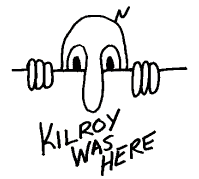 Close Topic Options
Close Topic Options21 Questions (and A Deep Breath!) - Page 24 of 62
I could never figure out before about the - Page 24 - Jokes, Humor, Forum Games - Posted: 20th Oct, 2008 - 7:05pm
Page 24 Breath Deep and Questions
| QUOTE (alskann @ 17-Oct 08, 5:06 PM) | ||
That is the closest guess yet. I am something that is usually drawn. |
I was doing a bit of research today with the newer clues that have been given. I have been really lost on this one! But I know that Alaskann can be kind of crazy!
So Klar was the closest with a Babe on the side of a plane!
Styx has a song about it? Was it on a popular album?
You are a picture of you and are cute, (of course!)
*Writing this makes me realize I STILL don't know much! *
Are you political in nature?
Are you a portrait?
Breath Deep and Questions
Styx has an album that was inspired by me.
I don't think I am political in any way.
Am I a portrait? Well, sort of. More of a charicature.
I figure we'll give the guys a chance to give it a go before I produce the answer unless someone guesses it first. ![]()
 Edited: alskann on 19th Oct, 2008 - 9:18pm
Edited: alskann on 19th Oct, 2008 - 9:18pm
21 Questions and Deep Breath! - Page 24
[IMG][IMG]https://i196.photobucket.com/albums/aa243/alskann/kroy-small.gif[/IMG][/IMG]
I was hoping to be able to make the picture show but I'm not that talented apparently.
Source 2
| QUOTE |
| Kilroy was here is an American popular culture expression, often seen in graffiti. Its origins are open to speculation, but recognition of it and the distinctive doodle of "Kilroy" peeking over a wall is known almost everywhere among U.S. residents who lived during World War II through the Korean War. |
| QUOTE |
| The phrase appears to have originated through United States servicemen, who would draw the doodle and the text "Kilroy Was Here" on the walls or elsewhere they were stationed, encamped, or visited. Brewer's Dictionary of Phrase and Fable notes that it was particularly associated with the Air Transport Command, at least when observed in the United Kingdom. The most widely accepted origin of "Kilroy Was Here" appears in author Timothy B. Benford's book The World War II Quiz & Fact Book, and various of his later works about the war. One theory identifies James J. Kilroy, an American shipyard inspector, as the man behind the signature. During World War II he worked at the Fore River Shipyard in Quincy, Massachusetts, where he claimed to have used the phrase to mark rivets he had checked. The builders, whose rivets J. J. Kilroy was counting, were paid depending on the number of rivets they put in. A riveter would make a chalk mark at the end of his or her shift to show where they had left off and the next riveter had started. Unscrupulous riveters discovered that, if they started work before the inspector arrived, they could receive extra pay by erasing the previous worker's chalk mark and chalking a mark farther back on the same seam, giving themselves credit for some of the previous riveter's work. J.J. Kilroy stopped this practice by writing "Kilroy was here" at the site of each chalk mark. At the time, ships were being sent out before they had been painted, so when sealed areas were opened for maintenance, soldiers found an unexplained name scrawled. Thousands of servicemen may have potentially seen his slogan on the outgoing ships and Kilroy's omnipresence and inscrutability sparked the legend. |
So Krakyn, You're up I suppose.
21 Questions and Deep Breath! Jokes Humor & Forum Games - Page 24
I could never figure out before about the images either but JB told me how to do it.
[OFFTOPIC]When you hit reply, under the smilies there is a place to upload a picture. Let's hope I got it right because that is how I am going to do it for you!)
That was such a hard one! Go easy on us Krakyn! ![]() !
!

21 Questions (and A Deep Breath!) (Hover)
 TOPIC: 21 Questions (and A Deep Breath!)
TOPIC: 21 Questions (and A Deep Breath!)